Minimum lot size; dimensional regulations; general. Dimensional regulations for each of the zoning districts are provided in the tables for the respective zones contained herein. These regulations apply to vacant areas which are defined as having no principal buildings within 500 feet in A zones, and within 300 feet in R, C and I zones, as measured along the street line in either direction from the center of the lot in question. Dimensional regulations for built-up areas where different from vacant areas, area set forth in the footnotes. Built-up areas are defined as having one or more principal buildings within 500 feet in Z zones and 300 feet in R, C and I zones, as measured along the street line, in either direction from the center of the lot in question.
a. Agricultural and residential zones.
(1) Minimum lot area and density requirements for areas with no public sewer and no public water facilities.
AGRICULTURAL AND RESIDENTIAL ZONES
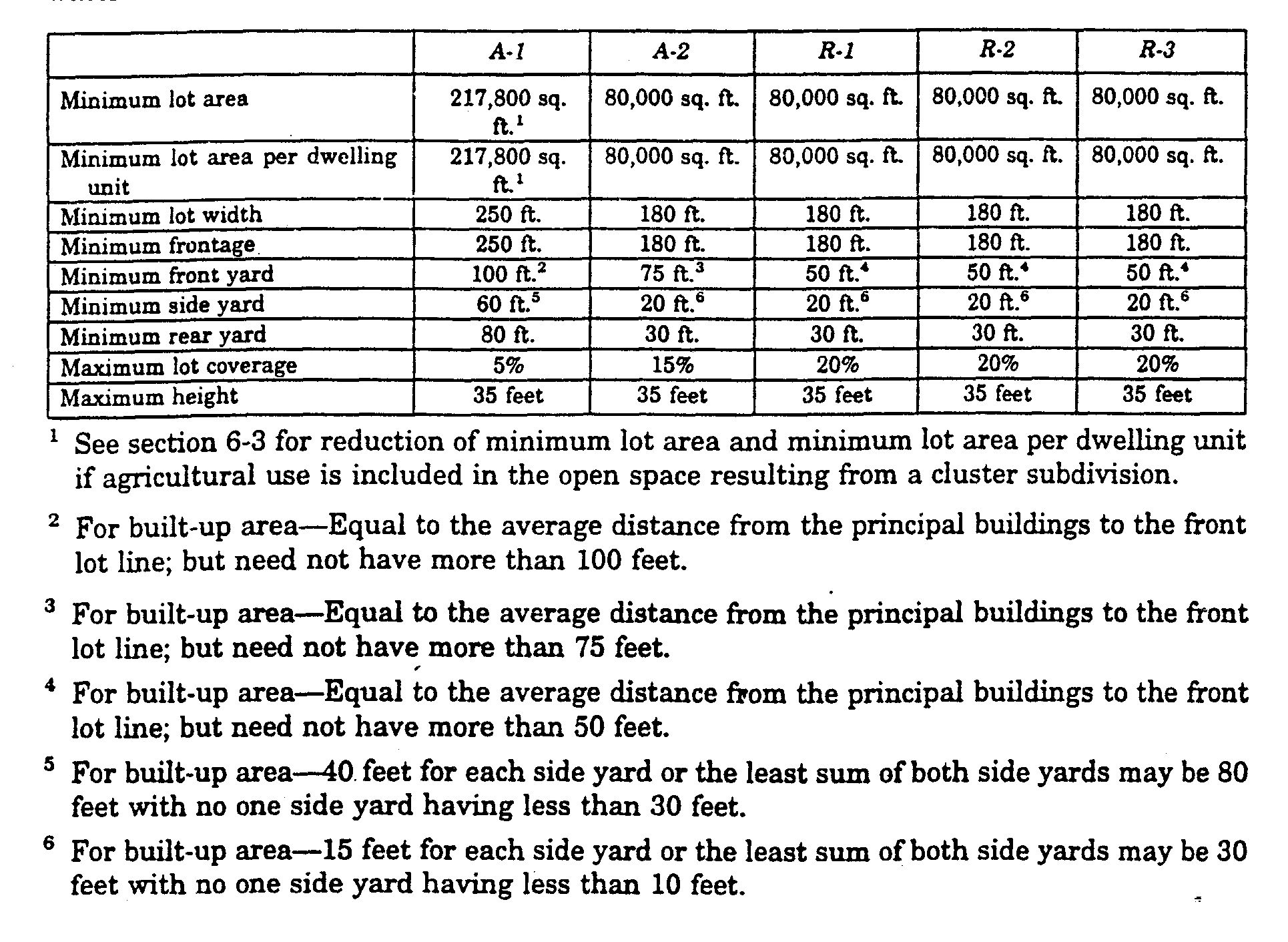
1.See section 6-3 for reduction of minimum lot area and minimum lot area per dwelling unit if agricultural use is included in the open space resulting from a cluster subdivision.
2.For built-up area-Equal to the average distance from the principal buildings to the front lot line; but need not have more than 100 feet.
3.For built-up area-Equal to the average distance from the principal buildings to the front lot line; but need not have more than 75 feet.
4.For built-up area-Equal to the average distance from the principal buildings to the front lot line; but need not have more than 50 feet.
5.For built-up area-40 feet for each side yard or the least sum of both side yards may be 80 feet with no one side yard having less than 30 feet.
6.For built-up area-15 feet for each side yard or the least sum of both side yards may be 30 feet with no one side yard having less than 10 feet.
(2) Minimum Lot Area and Density Requirements for Areas with Public Sewer / No Water Facilities OR No Public Sewer / with Water Facilities
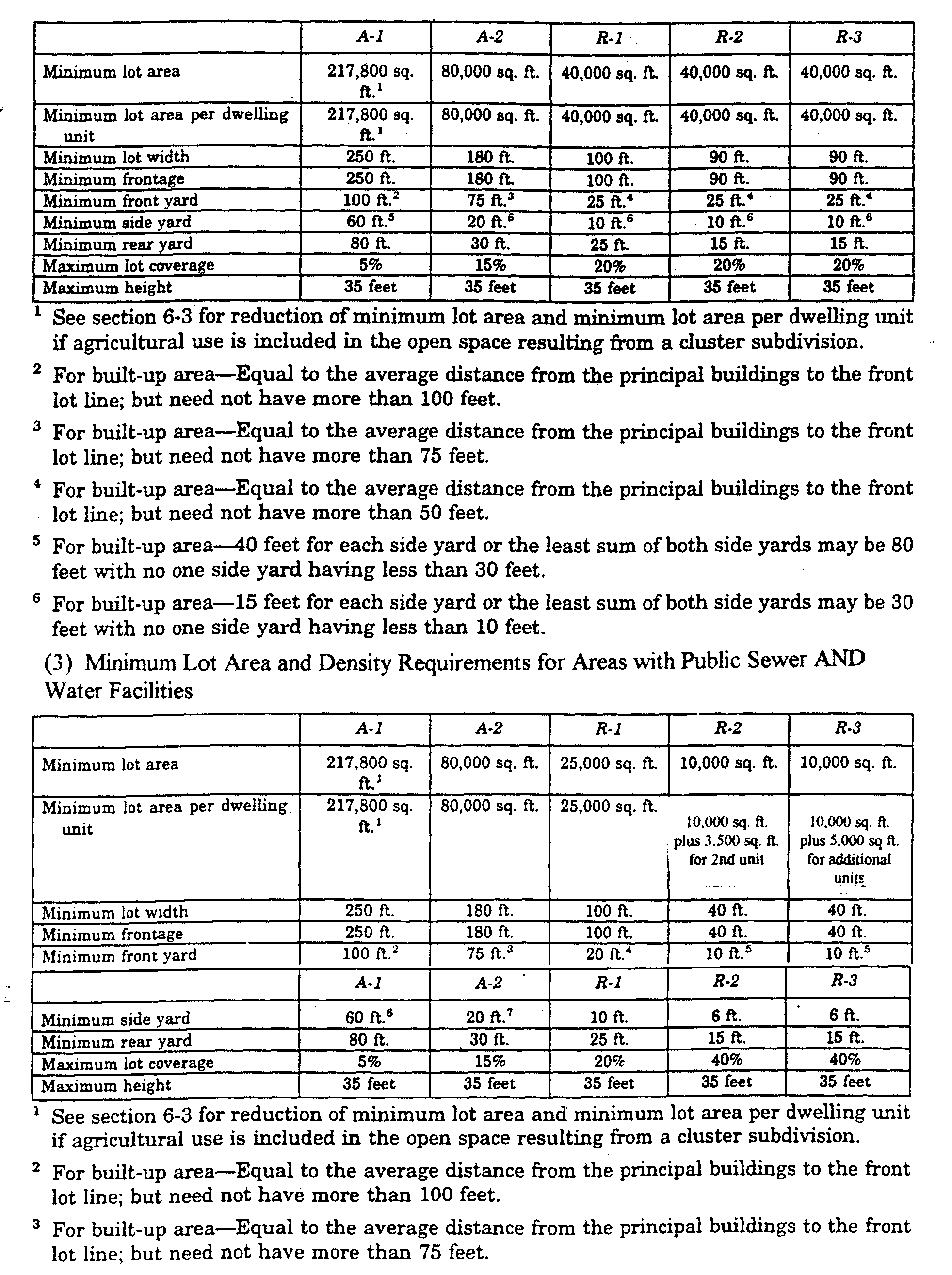
1.See section 6-3 for reduction of minimum lot area and minimum lot area per dwelling unit if agricultural use is included in the open space resulting from a cluster subdivision.
2.For built-up area-Equal to the average distance from the principal buildings to the front lot line; but need not have more than 100 feet.
3.For built-up area-Equal to the average distance from the principal buildings to the front lot line; but need not have more than 75 feet.
4.For built-up area-Equal to the average distance from the principal buildings to the front lot line; but need not have more than 50 feet.
5.For built-up area-40 feet for each side yard or the least sum of both side yards may be 80 feet with no one side yard having less than 30 feet.
6.For built-up area-15 feet for each side yard or the least sum of both side yards may be 30 feet with no one side yard having less than 10 feet.
(3) Minimum Lot Area and Density Requirements for Areas with Public Sewer AND Water Facilities
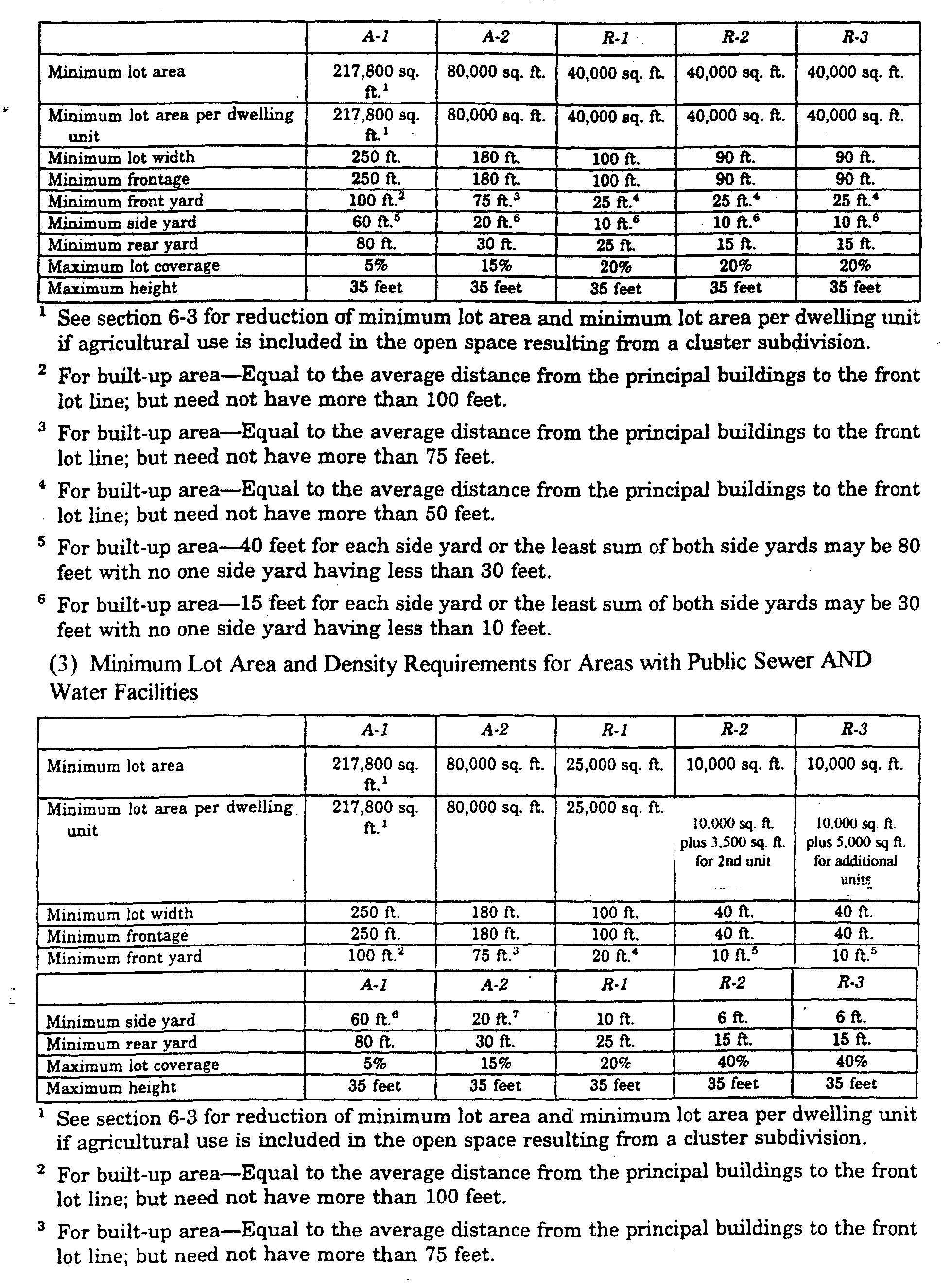
1.See section 6-3 for reduction of minimum lot area and minimum lot area per dwelling unit if agricultural use is included in the open space resulting from a cluster subdivision.
2.For built-up area-Equal to the average distance from the principal buildings to the front lot line; but need not have more than 100 feet.
3.For built-up area-Equal to the average distance from the principal buildings to the front lot line; but need not have more than 75 feet.
4.For built-up area-Equal to the average distance from the principal buildings to the front lot line; but need not have more than 15 feet.
5.For built-up area-Equal to the average distance from the principal buildings to the front lot line; but need not have more than 10 feet.
6.For built-up area-40 feet for each side yard or the least sum of both side yards may be 80 feet with no one side yard having less than 30 feet.
7.For built-up area-15 feet for each side yard or the least sum of both side yards may be 30 feet with no one side yard having less than 10 feet.
b. Commercial and industrial zones.
(1) Minimum lot area and density requirements for areas with no public sewer and no public water supply.
COMMERCIAL AND INDUSTRIAL ZONES
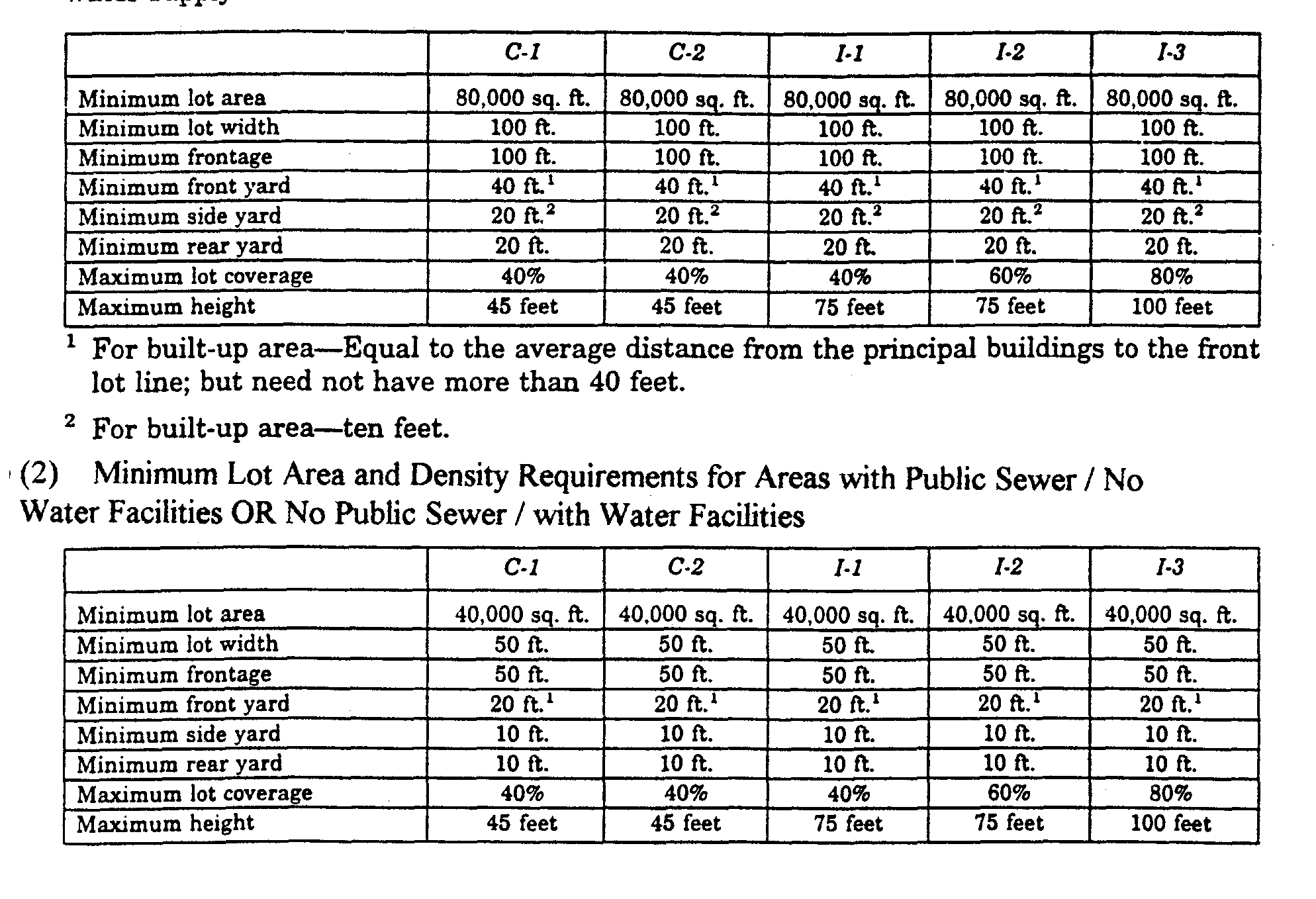
1.For built-up area-Equal to the average distance from the principal buildings to the front lot line; but need not have more than 40 feet.
2.For built-up area-ten feet.
(2) Minimum Lot Area and Density Requirements for Areas with Public Sewer No Water Facilities OR No Public Sewer / with Water Facilities
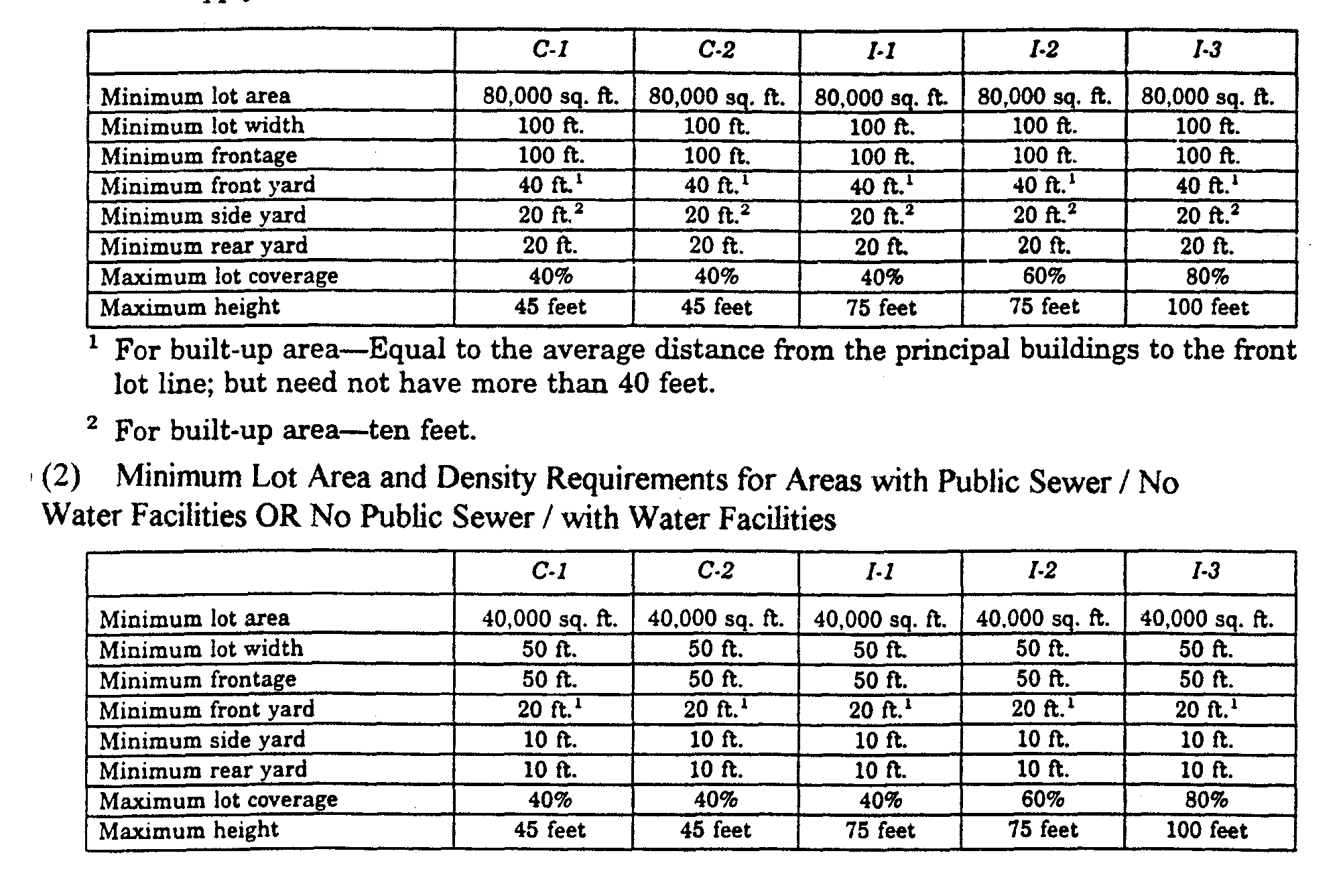
1.For built-up area-Equal to the average distance from the principal buildings to the front lot line; but need not have more than 20 feet.
(3) Minimum lot area and density requirements for areas with public sewer with water facilities.
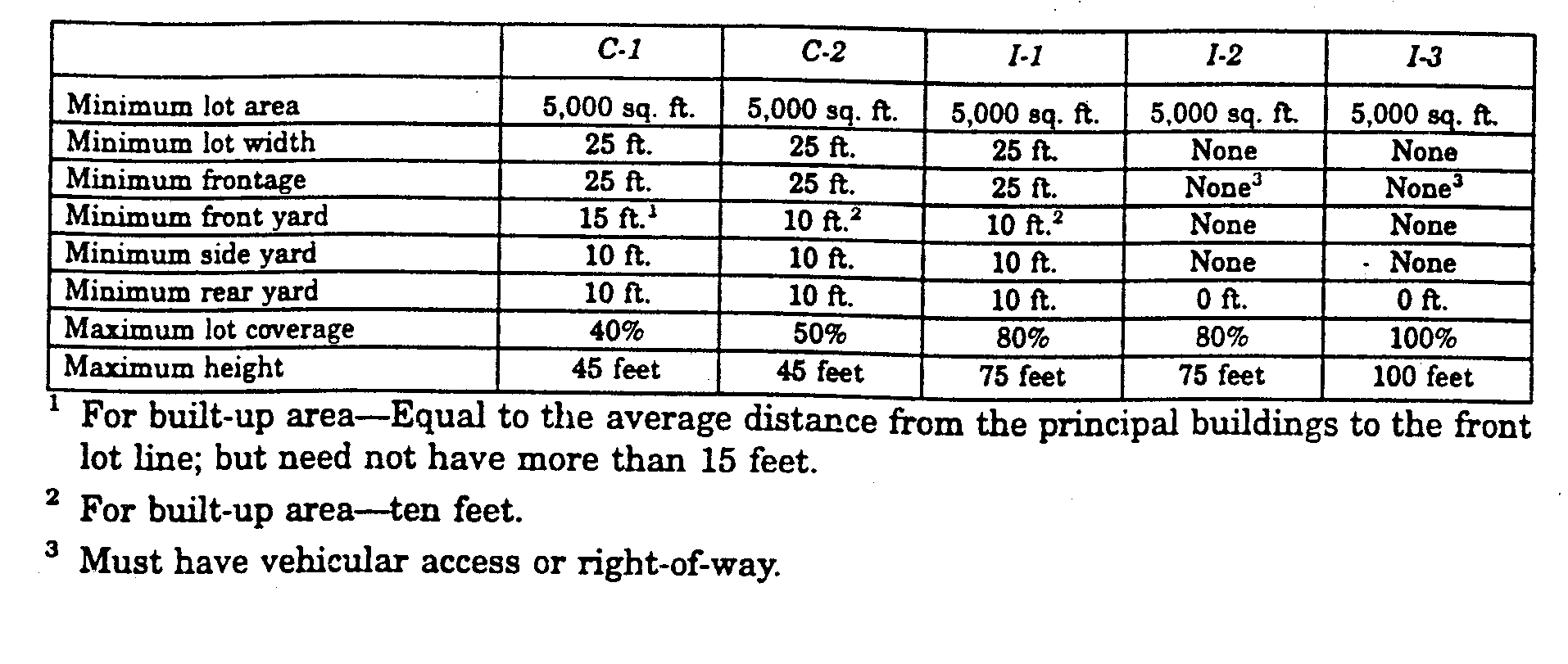
1.For built-up area-Equal to the average distance from the principal buildings to the front lot line; but need not have more than 15 feet.
2.For built-up area-ten feet.
3.Must have vehicular access or right-of-way.
The subdivider or developer shall, at his/her own expense, construct improvements to the land in accordance with the specifications of the regulations or as otherwise designated by town officials. Required improvements are as follows:
1. Street rights-of-way shall be cleared, cleaned and graded for the entire width in accordance with the specifications in Article C hereinbelow.
2. Streets shall be graded, graveled and paved in accordance with the specifications in Article C hereinbelow.
3. Street and traffic safety signs shall be installed immediately after recording. Street and traffic safety, signs shall be of the size, type and number specified by the town engineer in consultation with the Cumberland Police Department. In lieu of actual emplacement. the subdivider or developer may reimburse the Town of Cumberland for the cost of providing and installing such street and traffic safety signs.
4. Curb shall be installed in conformance with the specifications in Article C.6.b. Curbing may be waived by the planning board upon the recommendation and concurrence of the department of public works.
5. Sidewalks shall be required; but may be specifically waived if the planning board feels a safety hazard does not exist between vehicular and pedestrian traffic and if so required shall be installed in accordance with Article C.6.d.
6. Surface and subsurface storm drainage structures and facilities shall be installed, connected to catch basins, dry wells, watercourses or to the public storm sewer system if such connection is feasible. Such installation shall conform to the specifications in Article F, and the Standards Specification for Road and Bridge Construction published by the State of Rhode Island Department of Transportation. No connection to said storm drains shall be made without written approval of said connection by the town engineer.
7. Notwithstanding anything in these regulations, any retention or detention pond or surface drainage or retention facility of any sort whatsoever shall conform to the so-called Holding Pond Ordinance of the Town of Cumberland - Chapter 20, Article 20-31 through 20-39 of the Code of Ordinances.
8. Water mains may be required within the subdivision if any point of the perimeter of the subdivision or land development project is within one thousand (1,000) feet off public water system. In addition, if any point of the perimeter of the subdivision or the land development project is within five hundred (500) feet of a public water system, the board may require the subdivision or land development project to be connected to the said system.
9. Sanitary sewers shall be installed where required by the Town of Cumberland or the planning board in any subdivision or land development project.
10. Permanent monuments shall be placed at all corners in the exterior boundary of any subdivision or land development project, except at such corners which are inaccessible due to topography or non-development; and at such locations as the planning board may designate. Permanent monuments shall be installed and be of the type and materials as specified by Article F.
1. Construction Plans. One complete set of all construction plans, cross sections or other working drawings of required improvements to the land shall be submitted to the administrative officer and approved by the town engineer prior to any construction start.
Notification. No phase(s) or Steps in the construction of required improvements to the land shall commence until the town engineer. or his/her authorized representative, has been notified in writing at least twenty-four (24) prior thereto.
3. Inspection of improvement.
a. Each phase or step in the construction of required improvements to the land shall be inspected and approved in writing on the, job, by the town engineer or his/her authorized representative. No further phase or step shall commence until such inspection and approval has been completed.
b. The town engineer, or his/her authorized representative, upon proper notification of commencement of a phase or stage in construction shall not impede such construction by delaying inspection and approval without just cause.
c. Construction inspections, shall include, but not be limited to, the following:
1. Sanitary sewers must meet pressure test requirements.
2.Sanitary and storm sewers must pass visual inspection for alignment and cleanliness.
3. Water mains and hydrants shall be installed in accordance with the policies and practices of the Cumberland Water Department, and must be inspected by such department personnel as directed by the superintendent.
4. Storm drains shall have three (3) feet minimum cover.
5. Catch basins shall conform to R.I. standard 4.3.
6. Catch basin grates shall conform to R.I. standard 5.13.
7. Manholes shall conform to R.I. standard 3.1.
8. Manhole covers shall conform to R.I. standard 5.22.
9. Street construction:
(a) Curbing shall conform to R.I. standard 7.11 and be neatly aligned. (b) Gravel base materials, course depth and completion. (c) Sidewalk areas shall be graded to a true cross section. (d) Bituminous base course compacted thickness of one and one-half (1 - 1/2) inch shall be a smooth and neat surface free from defects. (e) Bituminous wearing course compacted thickness of one and one-half (1 1/2) inch shall be a smooth and neat surface free from defects.
4. Post-construction requirements.
a. Street and traffic safety signs, of a kind approved by the town engineer in consultation with the Cumberland Police Department, shall be installed.
b. Permanent monuments shall be set.
c. On the completion of construction and installation of all required improvements to the land and prior to the release of bond or certification of acceptance if no bond is posted, the subdivider or developer, shall furnish two (2) sets of "as-built" drawings of such improvements to the administrative officer. One copy of such improvement plans shall be a Mylar copy.
As-built drawings shall be revised copies of the recorded plat and such additional drawings as are required all of which shall be clearly marked "as-built drawings". Such "as-built" conditions shall be signed by the subdivider or developer and the contractor or contractors responsible for such changes certifying the "as-built" conditions indicated thereon.
d. Such reports and certifications that may be required by the town engineer to show that all improvements have been installed as required by the planning board and the Town of Cumberland.
1. Dimensions. All streets constructed within a subdivision or land development project shall conform to all applicable requirements in Section 11 of the regulations.
2. Clearing and grubbing. The entire right-of-way as shown on the plat shall be cleared and grubbed. All root systems, trees, maps, bushed, and other objectionable materials shall be removed and disposed of healthy trees within the right-of-way may be left standing provided they are not more than five (5) feet from the right-of-way line.
3. Earth excavation. Earth excavation shall include, but shall not be limited to, the removal of clay, sand gravel, loam, soft or disintegrated rock which can be removed without blasting, boulders of less than one-half (1/2) cubic yard in volume and other unacceptable materials within the limits of roadway, drainage or other excavation. Such excavation also includes backfilling of all stump holes and other surface irregularities with suitable fill materials property compacted. All excavations shall be of a depth and width as shown on the accepted plans, profiles and cross sections.
4. Rock and ledge excavation. Rock and ledge excavation shall include removal and disposal of all boulders one-half (1/2) cubic yard or more in volume and all hard ledge rock which can be removed only by drilling and splitting mechanically by hand or by blasting. Such excavation shall be at least six (6) inches below subgrade and, where appropriate, ledge side slopes shall be four (4) feet vertical to one (1) foot horizontal.
5. Subsurface water. Where free water is encountered within three (3) feet of finished grade, adequate drainage shall be constructed at a depth of at least (4) feet below finished grade.
6. Description of street construction.
a. Gravel base course. A gravel base meeting the graduation requirements of column 1, table 1, subsection M.01.09 of the Standard Specifications for Roads and Bridge Construction, published by the State of Rhode Island. Department of Transportation shall be placed on the subgrade and compacted to a depth of twelve (12) inches rolled in two (2) six (6) inch courses with a ten-ton roller or equivalent. If, in the opinion of the town engineer, the gravel base course is not of acceptably quality, crushed stone or crushed gravel meeting the gradation requirements of column 1, table 2, subsection M.01.09 of the R.I. standard specifications may be required as directed by the town engineer.
b. Curbs. Granite Curb Quarry Split shall meet the requirement of R.I. standard 7.51 and shall be set on a thoroughly compacted base of a minimum of three (13) inches of gravel and in good alignment with the roadway. Backfilling shall be done in accordance with suitable materials and thoroughly compacted as per RIDOT Division of Public Works standards.
c. Bituminous surface. On an approved gravel base provide a three (3) inch bituminous concrete pavement consisting of a separate binder and surface course with each course one and one-half (1 1/2) inches in compacted thickness.
d. Sidewalk areas and pedestrian rights-of-way. Sidewalks shall meet the requirements of section 901M of the R.I. standard specifications. If not paved sidewalks are to be constructed, the area between the curb and the street sideline shall be graded to a true cross section. If the subdivider or developer installs a paved sidewalk or pedestrian right-of-way. the materials for construction, the dimensions and the location of such walk shall be approved in advance by the planning board or its agent.
e. Drainage, culverts and bridges. All necessary drainage structures, culverts and bridges shall conform to the State of Rhode Island, Department of Transportation Standard Specifications for Roads and Bridge Construction. All sewer pipe shall be laid with watertight joints true to line and grade as shown on the plans and in conformance with requirements established by town engineer. When rock, shale, or other non-uniform material is encountered a minimum of four (4) inches of material shall be provided below the bottom of the pipe. This material shall be property compacted and shaped to the contour of the pipe. Trenches shall be backfilled with suitable materials properly placed and compacted. Backfill material shall be free from rocks, frozen materials or other objectionable materials larger than three (3) inches within one (1) foot of the top of the pipe. Where underdrain pipe is to be installed it shall be properly laid and provided with suitable filter material in the vicinity of the pipe and backfilled with suitable material to prevent clogging. All such drainage structures, culverts and bridges shall be installed and approved by the town engineer before covering.
7. Traffic limitation. Traffic passing over newly constructed streets shall be limited to wheeled vehicles only and no tracked equipment shall be allowed to pass.
1. Manholes. Manholes shall be located on all storm sewer trunk lines less than thirty (30) inches in diameter.
a. At maximum distances of three hundred (300) feet:
b. At all angles in the sewer line:
c. Al street interactions and other points where catch basins, inlets or laterals are to be connected.
d. At points where pipe changes.
e. All catch basins shall conform to R.I. standard 4.3 or approved modifications.
f. Catch basin and manhole covers shall conform to R.I. standards 5.13 and 5.22 respectively or approved equals.
2. Minimum cover. All subsurface drainage structures and facilities within street rights-of-way shall have a minimum cover of three (3) feet. All such drainage structures and facilities shall be inspected and approved by the town engineer before backfilling.
3. Settling of backfill. No paving shall constructed over pipe installations within street rights-of-way until the backfill has been allowed to settle for a minimum of thirty (30) days or has been suitably compacted.
All utility lines, curb stops and/or other subsurface facilities within the street rights-of-way shall be installed and the backfill allowed to settle for a minimum of thirty (30) days prior to the preparation of street subbase.
Installation of water mains shall be in conformance to the specifications of the Cumberland Water Department.
Installation of sewer lines shall be in conformance to the specifications required by the Cumberland Public Works Department.
1. Materials. Permanent monuments shall be stone or reinforced concrete, which shall conform in size and shape to the specifications in item 2 below.
2. Dimensions.
a. Monuments shall be thirty (30) inches in length and four (4) inches square.
b. A drill hole one-half (1/2) inch in diameter and three-fourths (3/4) of an inch deep shall be placed and centered on the top surface of the monument.
3. Setting monuments. All monuments shall be set flush with the finished grade.